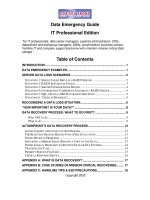Data Emergency Guide IT Professional Edition
Bạn đang xem bản rút gọn của tài liệu. Xem và tải ngay bản đầy đủ của tài liệu tại đây (146.61 KB, 22 trang )
Data Emergency Guide
IT Professional Edition
“for IT professionals, data center managers, systems administrators, CIOs,
department and workgroup managers, DBAs, small/medium business owners,
frontline IT and computer support personnel who maintain mission critical data
storage.”
Table of Contents
INTRODUCTION.................................................................................................. 1
DATA EMERGENCY EXAMPLES....................................................................... 1
SERVER DATA LOSS SCENARIOS................................................................... 2
S
ITUATION
1: S
INGLE
F
AILED
D
RIVE IN A
RAID5 S
ERVER
..............................................2
S
ITUATION
2: RAID5 S
ERVER HAS
F
AILED
......................................................................3
S
ITUATION
3: S
ERVER
U
PGRADE
G
ONE
W
RONG
..............................................................4
S
ITUATION
4: I
NTERMITTENT
C
OMPONENT
F
AILURE IN A
RAID5 S
ERVER
......................4
S
ITUATION
5: SQL, O
RACLE
, DB2 D
ATABASE
C
ORRUPTION
..........................................5
S
ITUATION
6: “C
RISIS IN
P
ROGRESS
”................................................................................5
RECOGNIZING A DATA LOSS SITUATION....................................................... 6
“HOW IMPORTANT IS YOUR DATA?”.............................................................. 8
DATA RECOVERY PROCESS: WHAT TO DO FIRST? ..................................... 8
What NOT to do:..........................................................................................................8
What to do: ..................................................................................................................9
ACTIONFRONT’S DATA RECOVERY PROCESS............................................ 13
I
NITIAL
I
NQUIRY AND
C
ONSULTATION
P
ROCESS
............................................................13
T
HE
R
ECOVERY
P
ROCESS
B
EGINS WITH A
F
REE
E
VALUATION
.......................................13
F
IXING
P
HYSICAL
P
ROBLEMS
.........................................................................................13
O
BTAINING A
M
IRROR
I
MAGE
(M
AKING A
C
OPY OF THE
D
ATA
) ....................................13
F
IXING
L
OGICAL
P
ROBLEMS
: C
ORRUPTED
F
ILES OR
F
ILE
S
YSTEMS
...............................14
T
RACKING THE
C
ASE
......................................................................................................14
P
RIORITY
S
ERVICE
F
EATURES
........................................................................................15
C
RITICAL
R
ESPONSE
S
ERVICE
........................................................................................16
APPENDIX A: WHAT IS DATA RECOVERY?.................................................. 17
APPENDIX B: CASE STUDIES OF MISSION CRITICAL RECOVERIES......... 17
APPENDIX C: HANDLING TIPS & ESD PRECAUTIONS................................. 18
Copyright 2002
www.ActionFront.com
Page 1
(800) 563-1167
Introduction
This guide is intended to help you recognize, react appropriately to and resolve a
data loss emergency involving servers, backups, and or any mission critical
computer system or IT facility.
The Data Emergency Guide: IT Professional Edition will be most useful to
technical support personnel, IT managers and anyone experiencing a sudden
data loss situation involving a previously functioning computer system or backup,
or dealing with the accidental erasure of data or overwriting of data control
structures.
For more general information about data storage, backups and data loss
prevention for personal computer users, please see the original Data Emergency
Guide. (Available as a free download at www.ActionFront.com
.)
Data Emergency Examples
• A multi-drive RAID server has crashed and no longer serves data to the
corporate network. (NAS, DAS or SAN architectures.)
• A set of medical images stored on a digital tape cartridge can no longer be
restored to other media.
• Failed upgrade of hardware, O/S or application software.
• Failed restore: an attempt to recover lost data has not only failed but rendered
the entire system unusable.
A data emergency usually begins with one of the following situations:
• The sudden inability to access any data from a previously functioning
computer system or backup.
• The accidental erasing of data or overwriting of data control structures.
• Data corruption or inaccessibility due to physical media damage or operating
system problems.
www.ActionFront.com
Page 2
(800) 563-1167
The situation cannot be resolved “in-house” or with the assistance of vendor
technical support or the regular 3
rd
party maintenance service provider.
Server Data Loss Scenarios
Properly maintained data storage systems are generally reliable, fault-tolerant,
and well managed by experienced operators who carry out their routine duties
well. When these systems do fail, it is a rare event; often the first time the
operator has been faced with these circumstances. It can be (understandably)
beyond the training and experience of most of the technical community, let alone
the owner/operator or department manager who must double as the systems
administrator. Both managers and technicians, especially those who carry
multiple responsibilities, can make mistakes when in unfamiliar territory. Our
professional data recovery specialists deal with these situations every day and
are well qualified to address the problems.
Proper diagnosis of problems is the key to successful management of a data loss
emergency. Who is qualified to diagnose your situation? Did you install the
system and do you possess the knowledge and experience to diagnose the
problem? If someone else set up the system, is it better to call them or other
outside experts? A proper diagnosis will then dictate whether:
• To call in our data recovery specialists or
• Initiate a self-fix, (assuming that there is an adequate backup).
If you experience a data emergency in the future, you may well recognize your
situation as similar to one of these scenarios. Proper diagnosis and follow up
can save your data and perhaps much more.
Situation 1: Single Failed Drive in a RAID5 Server
• A single drive failure in a RAID5 server has been detected but the server is
still operating and serving data to the users.
• The server may or may not have other problems beyond a single failed drive.
The operator is not able to do a complete diagnosis.
• Relying on the “hot fix” capabilities thought to be inherent in the system, the
operator is tempted to replace the failed drive “on-the-fly” thereby sparing the
users any downtime.
• Yielding to the temptation, the hot fix is attempted.
o If successful, the operator is an unrecognized hero, as the users were
never affected by problem.
o If unsuccessful, the operator may become the very “visible villain”
rather than an “invisible hero” and be seen to be responsible for a
prolonged period of server downtime and all the related problems
caused by the downtime.
www.ActionFront.com
Page 3
(800) 563-1167
• What should be done in this case:
1. The very first thing in the proper course of action is to establish the
viability of a complete and integral backup of the current data, even if
this involves inconveniencing the users. A complete backup at this
point is ideal although an incremental backup may suffice if you have a
proven restore procedure based on a series of complete plus
incremental backups.
2. Next, restore the backup to the alternate, “contingency” server and
prove that it is operational, in case it is needed.
3. Confident that the contingency infrastructure is ready to go if needed,
the operator can proceed with a hot fix attempt or other procedures to
address to the situation.
Situation 2: RAID5 Server has Failed
• Multiple drives or a controller has failed in a RAID5 server, causing the server
to be inaccessible.
• There is no alternate server available or no adequate backup available to be
loaded on the alternate server.
• This means that you are faced with a full-fledged data emergency.
• Many operators faced with this situation will attempt a quick fix by trying some
combination of replacing the failed components and reconfiguring the system
to rebuild the failed array. Under these conditions, there are two possible
outcomes:
o A functioning server missing much or all of their data. The data and
file structures are likely mostly overwritten at this point making a
recovery very difficult or impossible.
o A non-functioning server and dimmer prospects for recovery. The data
and file structures are likely mostly overwritten at this point making a
recovery very difficult or impossible.
www.ActionFront.com
Page 4
(800) 563-1167
• The appropriate thing to do when faced with these conditions is to call
professional data recovery specialists.
• A professional data recovery specialist will begin their process by making a
mirror image of the data on each discrete media involved including any failed
drives that may need highly specialized data recovery techniques performed
in a lab facility. Then working from copies, and using proprietary programs
and methods they will rebuild the data set to the point where it can be
transferred to a working server.
Situation 3: Server Upgrade Gone Wrong
• Installing new application software, a new operating system or additional or
new hardware is often referred to as a server upgrade.
• This is not an everyday event and the operator may lack experience with the
process, not understanding, for example, that many upgrades require a data
re-initialization process that by nature destroys the existing data or file
system.
• During these upgrades a “dialogue box” poses a series of questions the
operator may answer without fully realizing the potential impact of the steps
involved. For example, the operator starts the data re-initialization process
after a warning is misunderstood or ignored. These and other problems can
occur during the upgrade that renders the server inaccessible.
• Need to upgrade your server?
o Never initiate an upgrade without first making sure you have a
complete and usable backup. The best way to do this is to restore
your backup to an alternate server proving that you have a fully
functional redundant server populated with current data.
Situation 4: Intermittent Component Failure in a RAID5 Server
• The electrical and mechanical problems that affect media and its electronic
components can be intermittent. While this can complicate any diagnosis, it
may also provide an opportunity to obtain a good backup during an interval
when the server is functioning correctly.
• Operators may do a “false fix” by replacing a functional component rather
than a failed component after misinterpreting warnings generated by the
server.
• Some servers have been configured to self-initiate a rebuild under certain
circumstances, potentially overwriting otherwise valid media.
• Before addressing an intermittent failure situation we again caution you to:
o Make sure you have a good backup.
o Check and double-check your diagnosis.
www.ActionFront.com
Page 5
(800) 563-1167
Situation 5: SQL, Oracle, DB2 Database Corruption
• A server has crashed or experienced O/S problems,
• Tables have been dropped or corruption has been introduced into the actual
database.
• The DBA (Database Administrator) has a high level of expertise regarding
databases and knows some database specific recovery techniques, but may
lack detailed knowledge of data storage platforms.
• They may try to re-initialize the database making the application functional but
losing all their data in the process.
• Another attempted fix is to use the transaction logs to “roll back” the database
to a “known good state”.
• This can be a good way to solve the problem if:
o The transaction logs have been examined and deemed to be good.
o The operation is attempted on an alternate server using a copy of the
problem data.
• There is often a preference to try the roll back on the primary server to save
time, as restoring to an alternate server can be a very lengthy process.
• If the corruption is a result of physical drive problems that have not been
addressed then a roll back on the problem server will only compound the
problem resulting in a further degraded system and a more costly data
recovery operation.
www.ActionFront.com
Page 6
(800) 563-1167
Situation 6: “Crisis in Progress”
ActionFront is often contacted by an organization that is in the midst of a crisis.
The situations have some or all of these characteristics:
• The server has lost data or become inaccessible to the users.
• Documentation is out of date, sketchy, wrong or simply does not exist and the
user knowledge level and understanding of the system is low.
• Backups are available but the process of restoring them is misunderstood or
worse, the backups are out of date or do not exist.
• The department manager or the in-house technical teams have tried some
fixes.
• 3
rd
party technicians (from the maintenance service provider or from the
vendor) have been called in and tried to rectify the situation and have
performed additional operations and attempted fixes.
• The various attempted fixes typically involve swapping out suspect
components and/or restoring backups to the original (corrupted) media.
• The server has not been fixed and is possibly further degraded than when the
situation started.
While the details may differ, all of these situations have in common:
• Lack of adequate backup and/or no proven restore procedure
• Lack of documentation or knowledge of the system configuration and all the
various hardware, software and O/S layers and how they work together.
Professional data recovery specialists will begin any recovery by mirroring each
discrete media involved. Knowing that they can always revert to the same
starting point, the lack of documentation can then be safely overcome through
analysis and experimentation based on strong knowledge and experience of data
storage.
Recognizing a Data Loss Situation
A data loss situation is usually characterized by the sudden inability to access
data involving a previously functioning computer system or backup or the
accidental erasure of data or overwriting of data control structures. This section
outlines the major symptoms of data loss.
Server Data Loss Symptoms/Issues
• Symptoms Related to Physical Problems
o Sudden Server crash during operation or power up.
o Ticking or grinding noises coming from one of the hard drives while
powering up or trying to access files. This symptom may precede
actual data access problems as the drive utilizes spare sectors.
o Single hard drive failure.
o Multiple drive failure.
o RAID controller alarm flashing..
o RAID controller failure rendering drives inaccessible.
o Intermittent drive failure resulting in configuration corruption.
o Visible fire or water damage.
www.ActionFront.com
Page 7
(800) 563-1167
• Symptoms Related to Soft (Logical) Problems
o Server will not reboot after “routine” upgrade to operating system or
applications.
o Boot drive filesystem problems involving the loss of critical
configuration data.
o Server storage systems registry configuration lost/overwritten.
o Accidental deletion of data.
o Accidental reformatting of partitions.
o Accidental reconfiguration of RAID drives.
o Accidental replacement of hard drive.
• Soft (Logical) or Physically Related Symptoms (Could be either)
o Server reboots but cannot access or even “see” attached storage.
o Failed or prematurely aborted restore.
o Applications are unable to run or load data.
o Extreme degradation of application performance.
o Folders that should be full of files open but appear empty.
o Inaccessible drives and partitions.
o Corrupted data.
Tape Media Data Loss Symptoms/Issues
• Corrupted tape headers:
o Tape appears empty of data (blank) but should be full.
o Tape should be full but has very little data.
o The tape is invisible to or inaccessible to the restore program.
• Accidental reformatting or erasure of tape.
• Tape has become un-spooled inside the cartridge.
• Obvious physical damage.
o Tape media stretched, snapped or split.
o Visible fire or water damage.
• Media surface contamination and damage.
o Tape cannot be read past a worn-out or contaminated area.
• Tape backup-software problems involving corrupt catalogue information or
corrupt data control structures.
Optical Media
• Sector read errors preventing access.
• Corrupted filesystem structures show empty or invalid (e.g. FAT, directories,
partition entries).
Auto-loaders and Jukeboxes
Both optical and tape media libraries or multi-volumes can be maintained through
automation. To secure an archival copy, a backup copy to be kept offsite or for
other reasons, rotations are required by the technicians to cycle the media in and
out of the autoloaders. As these can be complex systems, any rotational error
can cause data to be over-written.









